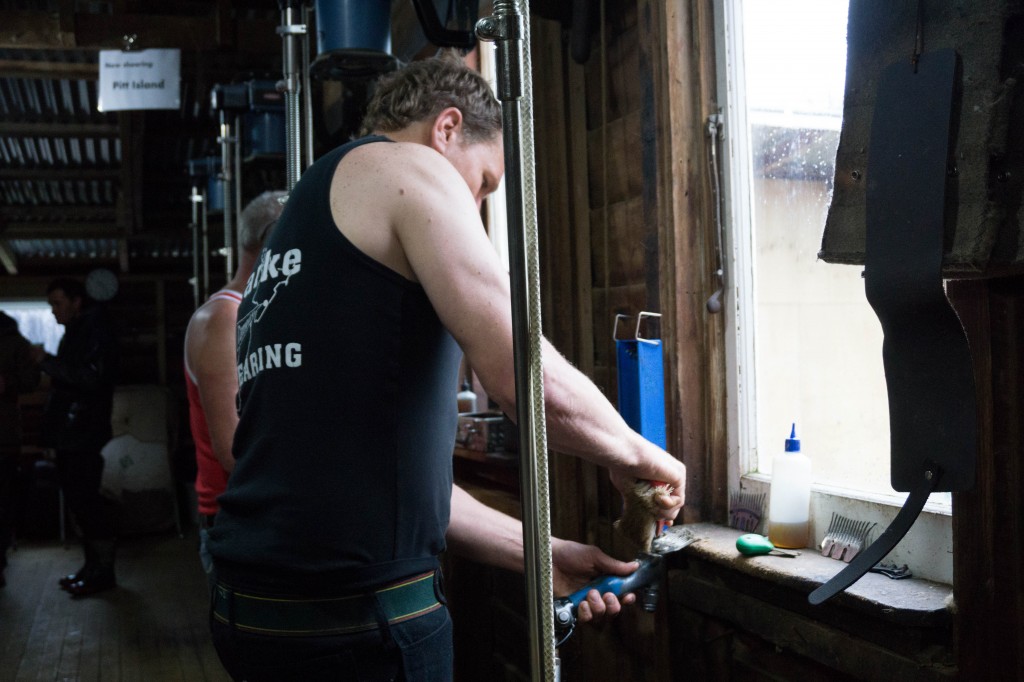
Every once in a while we have an opportunity to share a real treat, and last Sunday was one of them, a special day hosted by the Hale Family on their southern Hawkes Bay farm. It was a rainy day, and yet the scenery throughout our two hour drive was magnificent. The hills were draped in cloud and mist, the rain falling on emerald green fields and the early spring leaves just reaching out from the many trees adorning this part of the country. It made me think of the lives our forebears must have experienced, the early settlers come from european cities, with their cobbled streets and close buildings, suddenly thrown into the wilderness of unpastured New Zealand, complete with its regular downpours and misty days, in which the drops turn to downpours and the rivers swell.
And we arrived at the farm, greeted by the sight of a typical New Zealand red painted wood and tin shearing shed, nestled in the valley and beckoning with the warmth and smell of the sheep kept in overnight ready for shearing in the morning. It was muddy outside, but cosy and friendly inside, and as we arrived we saw the shearing was in full swing.
This was a special day, because this particular farm has a range of rare and unusual (for New Zealand) sheep breeds on the property. They are raised, as most sheep in this country, for dual purposes, some for their meat, and some for their fleece. I was looking forward to learning about some of the breeds I hadn’t encountered before, such as the New Zealand Pitt Island sheep, the South Asian Karukul, the Damara from Egypt, and I was looking forward to some nice spinning Gotland too 🙂
So rather than writing a book, I have a little video here to share with you, a glimpse at the shearers at work, some of the sheep we learned about, and a little information from Tracy White, a friend who is a qualified Wool Classer, and a great source of knowledge about fleece and breed standards, even in these more exotic fleeces! I hope you enjoy the video 🙂
Exotic Sheep Shearing: Hale Family Farm, Wimbledon, New Zealand 2014
Thank you !absolutely wonderful video.
That was fantastic! I really enjoyed it…thank you for taking time to share it!
WOW!!
What gorgeous creatures.
Makes me want to jump in and help.
Wonderful to see them work. Thanks for the video.
they seem so calm (the sheep) during all this
great to see this
thank you
Thank you for the video! I really enjoyed it. I wonder if there is a reason they use the hand shears rather than the electric clippers? I would love to visit and watch a shearing. Looks like a lot of work for all involved.
Hi! Glad you enjoyed it! One reason they gave for using the hand shears is that sometimes they want to leave more wool on the sheep, if its a bit cool still, and the hand shears do that. Another reason the guy in the video told us about was one day when he was shearing somewhere in Scotland, the power went out and they spent the day shearing with the hand shears, he says is still did over 100 sheep!
Finally a chance to watch this video. I loved it – it took me straight back to my “rowsie” days! The Pitt Island(?) sheep looked hard to shear – difficult not to get a lot of second cuts I would think. How I would like to get my hands on some of the rare wools – I am so excited by them, their potential, and I love to spin them. I do have some mohaka here but it is very tender.
I think they are very underestimated by NZ spinners.